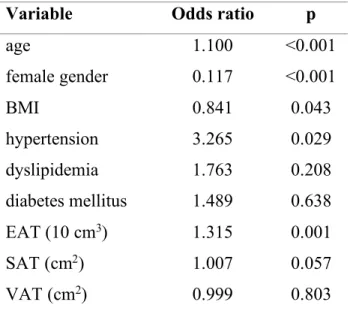Clinical implications of measuring epicardial adipose tissue quantity
PhD Thesis
Adam L. Jermendy, MD
Semmelweis University, Doctoral School of Basic and Translational Medicine
Supervisor:
Pál Maurovich-Horvat M.D., Ph.D.
Official reviewers:
Zsuzsanna Földes-Lénárd M.D., Ph.D.
Katalin Keresztes M.D., Ph.D.
Head of the Final Examination Committee Viktor Bérczi M.D., Ph.D.
Members of the Final Examination Committee:
Attila Doros M.D., Ph.D.
Tibor Hidvégi M.D., Ph.D.
Budapest 2019
2 1. INTRODUCTION
The epicardial adipose tissue (EAT) is a unique fat compartment localized between the myocardial surface and the visceral layer of the pericardium. EAT can be quantified by non-invasive cardiac imaging techniques such as echocardiography, MRI or cardiac CT.
Among physiological determinants of EAT age, gender, body weight and ethnicity should be considered. Physiological functions of EAT may include protection of the myocardium against hypothermia and a mechanical protective role for coronary circulation. In addition, EAT may serve as a unique energy buffering pool in the homeostasis of the myocardium.
As for pathophysiological functions it is widely accepted that EAT should be considered as a source of inflammatory mediators that might directly influence the myocardium and coronary arteries. In line with these observations, studies suggested that EAT - through paracrine and vasocrine effects - may have an impact on the development and progression of coronary atherosclerosis.
Generally, EAT volume and obesity parameters (weight, BMI and waist circumference) are closely related. Nevertheless, the clinical significance of abdominal subcutaneous adipose tissue (SAT) and visceral adipose tissue (VAT) differ. While abdominal SAT should be considered as a manifestation of enlarged fat depot, abdominal VAT - like an endocrine organ - is involved in the pathomechanism of the metabolic syndrome and may increase the cardiovascular risk through production of different cytokines.
No data are available whether EAT compartment quantity depends predominantly on genetic or environmental factors. Furthermore, data regarding the heritability of abdominal adipose tissue compartment sizes are scarce and the findings are based on family studies and on measurement methods with limited accuracy. In addition, only few
3
clinical data are available about the relationship of EAT quantity to the presence of coronary artery disease (CAD).
2. AIMS
After adopting a proper and reliable method for evaluating the quantity of EAT by using cardiac CT scan in our department, we designed a clinical twin study to evaluate the heritability of EAT quantity in comparison to that of abdominal SAT and VAT volumes. In addition, we performed a clinical study to evaluate the association between EAT quantity and the presence of CAD.
The aims of the study were
2.1. to evaluate the heritability of EAT quantity - for this reason a classical twin study was performed and genetic and environmental influences on EAT volumes were estimated; in addition, a special attention was paid to evaluating heritability of EAT in comparison to that of abdominal SAT and VAT volumes;
2.2 to assess the relationship of EAT volume to the presence of CAD - for this reason the association between EAT quantity and radiomorphological signs of CAD was simultaneously evaluated.
3. METHODS
3.1 Classical twin study to evaluate the heritability of EAT quantity in comparison to that of abdominal SAT and VAT The study was conducted as a part of the BUDAPEST-GLOBAL (Burden of atherosclerotic plaques study in twins - Genetic Loci and the Burden of Atherosclerotic Lesions) clinical study; the participants
4
had been co-enrolled with the large, international, multicenter Genetic Loci and the Burden of Atherosclerotic Lesions (GLOBAL) clinical study (http//:www.ClinicalTrials.gov: NCT01738828). In the BUDAPEST-GLOBAL clinical study we searched the Hungarian Twin Registry's database to identify adult (age >35 years) monozygotic (MZ) and same-sex dizygotic (DZ) twin pairs. Finally, 180 twin subjects (57 MZ twin pairs, 33 DZ twin pairs) were included from the BUDAPEST-GLOBAL study (Table 1). The national ethics committee (ETT TUKEB) approved the BUDAPEST-GLOBAL study. All patients provided written, informed consent before the investigations. The study was carried out according to the principles stated in the Declaration of Helsinki.
3.1.1. EAT volumetric assessment
Every subject underwent a non-contrast enhanced CT scan of the heart using a 256-slice CT scanner (Philips Brilliance iCT, Philips Healthcare, Best, The Netherlands; 120 kVp with tube current of 20 to 50 mAs depending on BMI, gantry rotation time 270 ms). The pericardial space was manually traced in each CT-slice in the non- contrast enhanced native cardiac CT data sets. The adipose tissue was defined as tissue in the attenuation range of -45 to -195 HU (Hounsfield unit). EAT was defined as any adipose tissue within the visceral pericardium from the level of the right pulmonary artery to the diaphragm. The EAT segmentation was automatically interpolated within the manually traced region of interest (ROI), and the volume was calculated by using an offline workstation (Extended Brilliance Workspace, Philips Healthcare, Best, The Netherlands).
Representative cases from the twin study can be seen in Figure 1.
5
Table 1. Clinical-laboratory data and fat compartments measured in twin subjects (mean±SD)
Variables Total MZ DZ
n = 180 n = 114 n = 66 p
Demographic, basic hemodynamic characteristics and medical history
Female (n, %) 114 (63.3%) 68 (59.6%) 46 (69.7%) 0.52
Age (years) 55.8 ± 9.6 54.3 ± 9.7 58.4 ± 8.6 <0.01
Height (cm) 166.4 ± 9.6 166.7 ± 10.1 165.9 ± 8.8 0.63
Weight (kg) 77.2 ± 17.5 77.6 ± 18.3 76.4 ± 16.2 0.67
BMI (kg/m2) 27.7 ± 5.2 27.7 ± 5.1 27.8 ± 5.4 0.98
Waist (cm) 96.9 ± 14.2 96.8 ± 14.6 96.9 ± 13.6 0.96
Hypertension (n, %) 76 (42.2%) 42 (36.8%) 34 (51.5%) 0.84
Diabetes mellitus (n, %) 15 (8.3%) 9 (7.9%) 6 (9.1%) 0.89
Dyslipidemia (n, %) 80 (44.4%) 46 (40.4%) 34 (51.5%) 0.48
Current smoker (n, %) 28 (15.6%) 17 (14.9%) 11 (16.7%) 0.88
Laboratory parameters
Fasting blood glucose (mmol/l) 5.35 ± 1.34 5.31 ± 1.48 5.41 ± 1.06 0.66
HbA1c (%) 5.5 ± 0.9 5.5 ± 0.9 5.3 ± 0.9 0.13
Serum total cholesterol (mmol/l) 5.56 ± 1.09 5.63 ± 1.11 5.42 ± 1.07 0.21
Serum LDL-cholesterol (mmol/l) 3.47 ± 0.99 3.52 ± 1.04 3.37 ± 0.89 0.32
Serum HDL-cholesterol (mmol/l) 1.62 ± 0.39 1.61 ± 0.41 1.65 ± 0.35 0.56
Triglycerides (mmol/l) 1.57 ± 1.09 1.62 ± 1.23 1.47 ± 0.77 0.36
Serum creatinine (µmol/l) 80.0 ± 9.0 80.0 ± 9.0 80.0 ± 9.0 0.41
Serum CRP (mg/l) 2.9 ± 4.5 2.7 ± 2.9 3.3 ± 6.5 0.37
Serum leptin (ng/ml) 18.4 ± 17.9 16.2 ± 13.5 22.4 ± 23.6 0.06
CT-based fat measurements Epicardial fat (mm3)
Subcutaneous fat (mm2) 97.1 217.9 ±
± 45.4
97.4 94.9 218.6 ±
± 43.2
90.1 101.0 216.7 ±
± 49.2
109.4 0.38 0.90
Visceral fat (mm2) 156.6 ± 87.9 158.9 ± 89.2 152.6 ± 86.0 0.64
6
Figure 1. Measurement of EAT quantity
a) Axial CT image of the heart, the pericardial layer is outlined with green, the epicardial fat is marked with yellow color
b) Volume rendered reconstruction of the epicardial fat volume c) - d) Representative cases from the study: epicardial fat volume in
a monozygotic twin pair
7
3.1.2. Assessment of abdominal SAT and VAT
A non-contrast enhanced single 5 mm thick slice (120 kVp; 200 mA;
gantry rotation time, 270 ms) was acquired subsequently after the native cardiac scan at the level of L3-L4. The single CT slice was loaded onto the offline workstation and SAT and VAT areas (cm2) were measured (Figure 2).
The native CT of the heart and abdomen resulted in a small (0.70 ± 0.16 mSv) radiation dose.
Figure 2. Abdominal SAT and VAT in MZ twin pairs
a-b) Axial images of the abdomen at the level of the L3/L4 vertebrae. Subcutaneous fat (orange color) is predominant in this MZ twin pair.
c-d) Axial images of the abdomen at the level of the L3/L4 vertebrae. Visceral fat (blue color) is prominent in this MZ twin pair.
8
3.1.3. Reproducibility of measuring EAT, SAT and VAT quantities
Two readers performed repeated measurements on 10-10 randomly selected MZ and DZ twin pairs and one reader repeatedly measured 10 randomly selected DZ twin pairs’ images in order to determine the inter-reader and intra-reader variability (ICC: intra-class correlation coefficient).
3.2. Assessing relationship of EAT quantity to the presence of CAD
3.2.1. Cardiac CT
Prospectively ECG-triggered coronary CT angiography (CTA) was performed using a 256-slice multidetector CT (Brilliance iCT, Philips Health Care, Best, The Netherlands). Images were acquired during a single inspiratory breathhold. Triphasic contrast injection protocol was used with 80 mL of iodinated contrast agent in average (Iomeprol 400 g/cm3, Iomeron, Bracco Imaging S.p.A., Milano, Italy). The mean effective radiation dose of the coronary CTA scans was 3.64±1.04 mSv. All image analyses were performed offline on dedicated cardiac workstations.
3.2.2. Coronary plaque assessment
The coronary CTA data sets were analyzed on qualitative and quantitative basis. Each coronary segment was assessed for presence of plaque, plaque type, degree of stenosis, plaque features and plaque attenuation pattern. Coronary plaque was classified as non-calcified plaque, partially calcified plaque or calcified plaque. Stenosis was graded as none, minimal (<25%), mild (25%-49%), moderate (50%- 69%), severe (70%-99%), or occlusion (100%), based on visual estimation of percent diameter stenosis. Coronary CTA was evaluated
9
on subject-to-subject basis and subjects were classified with and without CAD (CAD-positive and CAD-negative subjects).
3.3. Statistical analysis
Continuous variables are expressed as mean ± standard deviation (SD), whereas categorical variables are expressed as numbers and percentages. MZ and DZ twins were compared using Student's t-tests and Chi-square tests. Correlations were calculated using Pearson correlation coefficients. Coefficient values are interpreted as: 1.00 – 0.81: excellent; 0.80 - 0.61: good; 0.60 - 0.41: moderate; 0.40 - 0.21:
fair; 0.20 – 0.00: poor. Descriptive statistics, correlations and reproducibility measurements were calculated using IBM SPSS Statistics version 23 (IBM, Armonk, NY, USA).
Heritability was assessed in two steps. First, co-twin correlations between the siblings were analyzed in MZ and DZ pairs separately.
Then, genetic structural equation models (A-C-E “best fitting”
models) were used to quantify the magnitude of genetic and environmental factors (A: additive genetic components, C: common environmental factors, E: unique environmental factors) influencing the different fat compartments. All calculations were adjusted for age and sex. Log likelihood-based 95% confidence intervals (CI) were calculated for all estimated parameters. All calculations were performed using R version 3.2.5. Twin modelling was performed using OpenMx version 2.5.2.
In the study for evaluating association between EAT quantity and CAD we used Student’s unpaired t-test for assessing the statistical difference between CAD-pos and CAD-neg groups and a robust maximum likelihood estimation for correcting the potential bias from set of twins. We estimated the association between CAD and risk factors (inclusive EAT, SAT and VAT values) using a logistic regression analysis. We used female gender, age, BMI, hypertension
10
dyslipidemia, diabetes mellitus, EAT, SAT and VAT in the model. A p value <0.05 was considered significant.
4. RESULTS
4.1. Heritability of EAT quantity in comparison to abdominal SAT and VAT volumes
Intra-reader agreement showed excellent reproducibility for all CT based fat measurements as intra-class correlations (ICC) proved to be higher than 0.98 (ICCEAT = 0.99; ICCSAT = 0.98; ICCVAT = 0.99). We also found excellent reproducibility regarding inter-reader variability (ICCEAT = 0.98; ICCSAT = 0.99; ICCVAT = 0.99).
Co-twin correlations between the siblings showed that for all three parameters, MZ twins have stronger correlations than DZ twins, suggesting prominent genetic effects (EAT: rMZ = 0.81, rDZ = 0.32;
SAT: rMZ = 0.80, rDZ = 0.68; VAT: rMZ = 0.79, rDZ = 0.48).
For all three fat compartments AE model excluding common environmental factors proved to be best fitting [EAT: A: 73% (95%
CI = 56%-83%), E: 27% (95% CI = 16-44%); SAT: A: 77% (95% CI
= 64%-85%), E: 23% (95% CI = 15%-35%); VAT: A: 56% (95% CI
= 35%-71%), E: 44% (95% CI = 29%-65%)].
In multi-trait model fitting analysis overall contribution of genetic factors to EAT, SAT and VAT was 80%, 78% and 70%, whereas that of environmental factors was 20%, 22% and 30%, respectively (Table 2).
Results of the multi-variate analysis suggest that a common latent phenotype is associated with the tissue compartments investigated.
Based on our results, 98% (95% CI = 77%-100%) of VAT heritability can be accounted by this common latent phenotype which also effects SAT and EAT heritability. This common latent phenotype accounts
11
for 26% (95% CI = 13%-42%) of SAT and 49% (95% CI = 32%-72%) of EAT heritability. This common latent phenotype is influenced by genetics in 71% (95% CI = 54%-81%) and environmental effects in 29% (95% CI = 19%-46%). (Figure 3).
These results all indicated that none of the phenotypes is independent of the other two, thus the heritability of EAT or SAT or VAT phenotype is associated with the remaining two phenotypes.
Taken together, genetic factors have substantial influence, while environmental factors have only a modest impact on EAT volume, abdominal SAT and VAT quantities. There is a considerable amount of common genetic background influencing the quantities of all three adipose tissue compartments.
Table 2. Proportion of common (c) and specific (s) genetic and environmental factors contributing to the phenotypic quantity of CT based fat measurements
Variable Epicardial fat Subcutaneous fat Visceral fat Common genetic and environmental factors
genetic factors (AC) 35% 18% 70%
environmental factors (EC) 14% 8% 28%
Specific genetic and environmental factors
genetic factors (AS) 45% 60% 0%
environmental factors (ES) 6% 14% 2%
Overall contribution of genetic and environmental factors
genetic factors (A) 80% 78% 70%
environmental factors (E) 20% 22% 30%
12
Figure 3. Proportion of phenotypic variance of CT-based fat measurements
Image shows squared standardized path coefficients of best fitting model. The common pathway model calculating with only common genetic and environmental factors proved to be the best. Residual variances were decomposed to specific genetic and environmental factors. In case of VAT only specific environmental factors were considered. Ac: common additive genetic factor, As: specific additive genetic factor Ec: common environmental factor, Es: specific environmental factor, EAT: epicardial adipose tissue, SAT:
subcutaneous adipose tissue, VAT: visceral adipose tissue
13
4.2. Assessing relationship of EAT quantity to CAD
We included 195 subjects in this study of which 89 subjects proved to be CAD-negative while 106 subjects were classified as CAD-positive (Table 3).
Table 3. Clinical characteristics and main laboratory findings in CAD-negative and CAD-positive patients [n (%), mean±SD)]
Variable CAD-negative patients
(n=89)
CAD-positive patients (n=106)
p
age (years) 51.9 ± 9.3 59.7 ± 8.0 <0.001
women 70 (78.6%) 55 (51.9%) <0.001
hypertension 20 (22.5%) 62 (58.5%) <0.001
dyslipidemia 30 (33.7%) 55 (51.9%) 0.014
diabetes mellitus BMI (kg/m2) weight (kg)
4 (4.5%) 26.4 ± 4.2 72.4 ± 13.5
14 (13.2%) 28.8 ± 5.6 81.0 ± 18.5
0.046 0.015 0.002 waist circumference (cm) 92.8 ± 11.2 100.4 ± 14.9 <0.001
EAT (cm3) 73.9 ± 27.3 117.2 ± 46.8 <0.001
SAT (cm2) 202.0 ± 83.5 230.3 ± 102.6 <0.001
VAT (cm2) EAT/SAT (cm3/cm2) EAT/VAT (cm3/cm2) EAT/BMI (cm3/kg x m-2)
115.5 0.41 0.75 2.80
±
±
±
± 60.1 0.21 0.38 0.90
190.7 0.64 0.75 4.00
±
±
±
± 89.9 0.51 0.51 1.50
<0.001
<0.001 0.982
<0.001
total cholesterol (mmol/l) 5.6 ± 1.0 5.5 ± 1.1 0.598
triglycerides (mmol/l) 1.3 ± 0.9 1.7 ± 1.1 0.021
LDL-cholesterol (mmol/l) 3.5 ± 1.0 3.5 ± 1.0 0.847
HDL-cholesterol (mmol/l) 1.7 ± 0.3 1.6 ± 0.4 0.070
fasting blood glucose (mmol/l) 5.2 ± 0.9 5.5 ± 1.6 0.056
14
Age (odds ratio [OR]: 1.100 p<0.001), hypertension (OR: 3.265 p<0.05), female sex (OR: 0.117 p<0.001) and the volume of EAT in 10 cm3 clusters (OR: 1.315 p=0.001) were independent predictors for CAD. A 10 cm3 increment in the volume of EAT increased the risk of CAD with 31%, independently from BMI values. Female sex was a protective factor, therefore male sex should be considered a positive predictive factor (Table 4).
Table 4. Association between CAD and clinical/laboratory parameters (risk factors, EAT, SAT, VAT) - results of the logistic regression analysis
Our results are in line with former observations documenting that EAT quantity are associated with the presence of CAD, suggesting that EAT may have a role in the development of atherosclerosis in the coronary arteries.
Variable Odds ratio p
age 1.100 <0.001
female gender BMI
0.117 0.841
<0.001 0.043
hypertension 3.265 0.029
dyslipidemia 1.763 0.208
diabetes mellitus 1.489 0.638
EAT (10 cm3) 1.315 0.001
SAT (cm2) 1.007 0.057
VAT (cm2) 0.999 0.803
15 5. CONCLUSIONS
We demonstrated that genetics have substantial, while environmental factors have only a modest influence on EAT, SAT and VAT volumes.
Our findings show that common and specific genetic effects both play an important role in developing these phenotypes. None of the phenotypic appearance of EAT, SAT and VAT proved to be completely independent of the other two.
We documented a relatively strong genetic dependence of EAT, which has not been described previously. The genetic dependence of anthropometric parameters (weight, height, BMI) has been well documented in former studies. Heritability of different ectopic fat compartments (hepatic lipid accumulation) was also investigated, and in this case environmental factors predominated over genetic influences. Hence, heritability of different adipose tissue compartments and that of ectopic fats may vary.
The presence of strong genetic predisposition does not automatically translate to the development of clinical disease phenotype.
Considering this fact, early and continuous preventive efforts should be implemented. In case of obesity, intervention should be initiated as early as possible and all modifiable risk factors should be addressed with diet, physical activity and behavioral interventions starting even in childhood.
We found that the quantity of EAT is associated - among others - with the presence of CAD. If causal relationship could definitively be proven, then, interventions should be considered reasonable to initiate for reducing EAT volume which might finally lead to a decrease in development of CAD. Moreover, it seems reasonable to involve EAT quantity into cardiovascular risk assessment, but the validity of this new method should be verified in prospective clinical studies.
16
6. BIBLIOGRAPHY OF THE CANDIDATE'S PUBLICATIONS
6.1. Publications closely related to the presented thesis
1. Jermendy AL, Kolossvary M, Drobni ZD, Tarnoki AD, Tarnoki DL, Karady J, Voros S, Lamb HJ, Merkely B, Jermendy G, Maurovich- Horvat P. (2018) Assessing genetic and environmental influences on epicardial and abdominal adipose tissue quantities: a classical twin study. Int J Obes, 42:163-168. IF:4.514
2. Nagy E*, Jermendy AL*, Merkely B, Maurovich-Horvat P. (2017) Clinical importance of epicardial adipose tissue. Arch Med Sci, 13:
864-874.
*: the authors contributed equally to the manuscript (review article)
3. Maurovich-Horvat P, Tárnoki DL, Tárnoki ÁD, Horváth T, Jermendy ÁL, Kolossváry M, Szilveszter B, Voros V, Kovács A, Molnár AÁ, Littvay L, Lamb HJ, Voros S, Jermendy G, Merkely B. (2015) Rationale, Design, and Methodological Aspects of the BUDAPEST- GLOBAL Study (Burden of Atherosclerotic Plaques Study in Twins- Genetic Loci and the Burden of Atherosclerotic Lesions). Clin Cardiol, 38:699-707. IF:2.431
Articles in Hungarian
4. Drobni Zs D, Kolossváry M, Karády J, Jermendy ÁL, Littvay L, Tárnoki ÁD, Tárnoki DL, Voros Sz, Jermendy Gy, Merkely B, Maurovich-Horvat P. (2017) Van-e összefüggés az epikardiális zsírszövet és a koszorúér-betegség között? Cardiologia Hungarica, 47:
25-29.
17
6.2. Publications not related to the present thesis
1. Szilveszter B, Oren D, Molnár L, Apor A, Nagy AI, Molnár A, Vattay B, Kolossváry M, Karády J, Bartykowszki A, Jermendy ÁL, Suhai FI, Panajotu A, Maurovich-Horvat P, Merkely B. Subclinical leaflet thrombosis is associated with impaired reverse remodelling after transcatheter aortic valve implantation. Eur Heart J Cardiovasc Imaging. 2019 Oct 30. doi: 10.1093/ehjci/jez256. IF:5.260
2. Tarnoki AD, Szalontai L, Fagnani C, Tarnoki DL, Lucatelli P, Maurovich-Horvat P, Jermendy AL, Kovacs A, Molnar AA, Godor E, Fejer B, Hernyes A, Cirelli C, Fanelli F, Farina F, Baracchini C, Meneghetti G, Gyarmathy AV, Jermendy G, Merkely B, Pucci G, Schillaci G, Stazi MA, Medda E. (2019) Genetic and environmental factors on heart rate, mean arterial pressure and carotid intima media thickness: a longitudinal twin study. Cardiol J. 2019 Sep 6. doi:
10.5603/CJ.a2019.0089. IF:1.743
3. Kiss LZ, Bagyura Z, Csobay-Novák C, Lux Á, Polgár L, Jermendy Á, Soós P, Szelid Z, Maurovich-Horvat P, Becker D, Merkely B.
(2019) Serum uric acid is independently associated with coronary calcification in an asymptomatic population. J Cardiovasc Transl Res, 12: 204-210. IF:2.756
4. Bikov A, Kolossváry M, Jermendy AL, Drobni ZD, Tarnoki AD, Tarnoki DL, Forgó B, Kovacs DT, Losonczy G, Kunos L, Voros S, Merkely B, Maurovich-Horvat P. (2019) Comprehensive coronary plaque assessment in patients with obstructive sleep apnea. J Sleep Res, 6: e12828. IF:3.432
5. Pucci G, Tarnoki AD, Medda E, Tarnoki DL, Littvay L, Maurovich- Horvat P, Jermendy AL, Godor E, Fejer B, Hernyes A, Lucatelli P, Fanelli F, Farina F, Baracchini C, Meneghetti G, Jermendy G, Merkely B, Schillaci G, Fagnani C, Stazi MA (2018). Genetic and environmental determinants of longitudinal stability of arterial stiffness and wave reflection: a twin study. J Hypertens, 36: 2316- 2323. IF:4.209
18
6. Lucatelli P, Fagnani C, Tarnoki AD, Tarnoki DL, Sacconi B, Fejer B, Stazi MA, Salemi M, Cirelli C, d'Adamo A, Fanelli F, Catalano C, Maurovich-Horvat P, Jermendy AL, Jermendy G, Merkely B, Molnar AA, Pucci G, Schillaci G, Farina F, Meneghetti G, Baracchini C, Medda E. (2018) Genetic influence on femoral plaque and its relationship with carotid plaque: an international twin study. Int J Cardiovasc Imaging, 34: 531-541. IF:1.860
7. Bartykowszki A, Kolossváry M, Jermendy ÁL, Karády J, Szilveszter B, Károlyi M, Balogh O, Sax B, Merkely B, Maurovich-Horvat P.
(2018) Image quality of prospectively ECG-triggered coronary CT angiography in heart transplant recipients. Am J Roentgenol, 210:
314-319. IF:3.161
8. Vecsey-Nagy M, Simon J, Szilveszter B, Karady J, Jermendy A, Merkely B, Maurovich-Horvat P. (2018) Role of Multidetector Computed Tomography in Transcatheter Aortic Valve Implantation - from Pre-procedural Planning to Detection of Post-procedural Complications. Journal of Cardiovascular Emergencies, 4: 178-186 9. Szilveszter B, Kolossváry M, Karády J, Jermendy ÁL, Károlyi M,
Panajotu A, Bagyura Z, Vecsey-Nagy M, Cury RC, Leipsic JA, Merkely B, Maurovich-Horvat P. (2017) Structured reporting platform improves CAD-RADS assessment. J Cardiovasc Comput Tomogr, 11: 449-454. IF:3.095
10. Karády J, Panajotu A, Kolossváry M, Szilveszter B, Jermendy ÁL, Bartykowszki A, Károlyi M, Celeng C, Merkely B, Maurovich-Horvat P. (2017) The effect of four-phasic versus three-phasic contrast media injection protocols on extravasation rate in coronary CT angiography:
a randomized controlled trial. Eur Radiol, 27: 4538-4543. IF:4.027 11. Fejer B, Tarnoki AD, Tarnoki DL, Lucatelli P, Littvay L, Maurovich-
Horvat P, Jermendy AL, Kovacs A, Godor E, Fagnani C, Stazi MA, Molnar AA, Fanelli F, Cirelli C, Farina F, Baracchini C, Meneghetti G, Pucci G, Jermendy G, Merkely B, Schillaci G, Medda E. (2017) Heritability of the femoral intima media thickness. Eur J Intern Med, 41: 44-48. IF:3.282
19
12. Celeng C, Kolossváry M, Kovács A, Molnár AÁ, Szilveszter B, Horváth T, Károlyi M, Jermendy ÁL, Tárnoki ÁD, Tárnoki DL, Karády J, Voros S, Jermendy G, Merkely B, Maurovich-Horvat P.
(2017) Aortic root dimensions are predominantly determined by genetic factors: a classical twin study. Eur Radiol, 27: 2419-2425.
IF:4.027
13. Károlyi M, Szilveszter B, Kolossváry M, Takx RA, Celeng C, Bartykowszki A, Jermendy ÁL, Panajotu A, Karády J, Raaijmakers R, Giepmans W, Merkely B, Maurovich-Horvat P. (2017) Iterative model reconstruction reduces calcified plaque volume in coronary CT angiography. Eur J Radiol, 87: 83-89. IF:2.843
14. Maurovich-Horvat P, Károlyi M, Horváth T, Szilveszter B, Bartykowszki A, Jermendy ÁL, Panajotu A, Celeng C, Suhai FI, Major GP, Csobay-Novák C, Hüttl K, Merkely B. (2015) Esmolol is noninferior to metoprolol in achieving a target heart rate of 65 beats/min in patients referred to coronary CT angiography: A randomized controlled clinical trial. J Cardiovasc Comput Tomogr, 9:
139-45. IF:2.472
15. Horváth T, Osztovits J, Pintér A, Littvay L, Cseh D, Tárnoki AD, Tárnoki DL, Jermendy AL, Steinbach R, Métneki J, Schillaci G, Kollai M, Jermendy G. (2014) Genetic impact dominates over environmental effects in development of carotid artery stiffness: a twin study. Hypertens Res, 37: 88-93. IF:2.658
16. Jermendy G, Horváth T, Littvay L, Steinbach R, Jermendy ÁL, Tárnoki ÁD, Tárnoki DL, Métneki J, Osztovits J. (2011) Effect of genetic and environmental influences on cardiometabolic risk factors:
a twin study. Cardiovasc Diabetol, 10: 96. IF:3.346
17. Osztovits J, Horváth T, Littvay L, Steinbach R, Jermendy Á, Tárnoki Á, Tárnoki D, Métneki J, Kollai M, Jermendy G. (2011) Effects of genetic vs. environmental factors on cardiovascular autonomic function: a twin study. Diabet Med, 28: 1241-1248. IF:2.902
20 Articles in Hungarian
1. Jermendy Gy, Littvay L, Steinbach R, Jermendy Á, Tárnoki Á, Tárnoki D, Métneki J, Osztovits J. (2011) A metabolikus szindróma összetevőinek genetikai meghatározottsága: ikervizsgálatok eredményei. Orv Hetil 152: 1265-1271.
2. Jermendy Gy, Horváth T, Littvay L, Steinbach R, Jermendy ÁL, Tárnoki ÁD, Tárnoki DL, Métneki J, Osztovits J. (2011) Kardiometabolikus kockázati tényezők és öröklődés: ikervizsgálatok eredményei. Metabolizmus 9: 304-309.
Cumulative impact factor of the candidate’s publications related to the thesis: 6.945
Cumulative impact factor of the candidate’s publications not related to the thesis: 51.073
Total cumulative impact factor of the candidate’s publications: 58.018
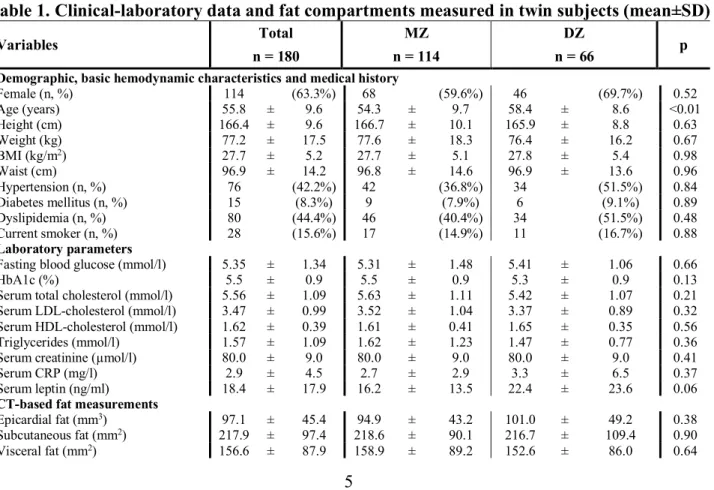
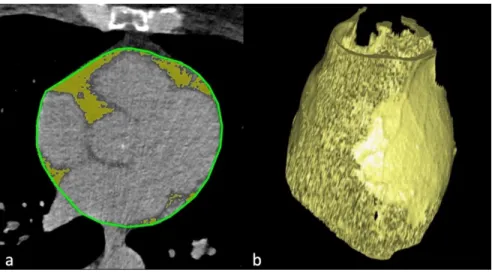
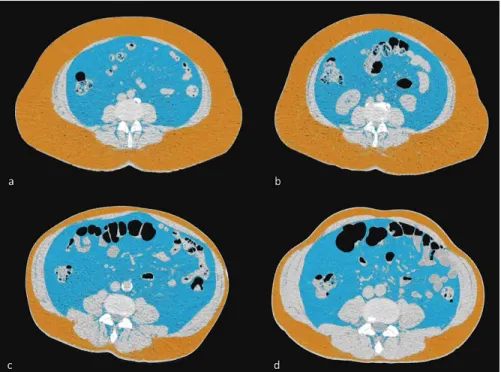
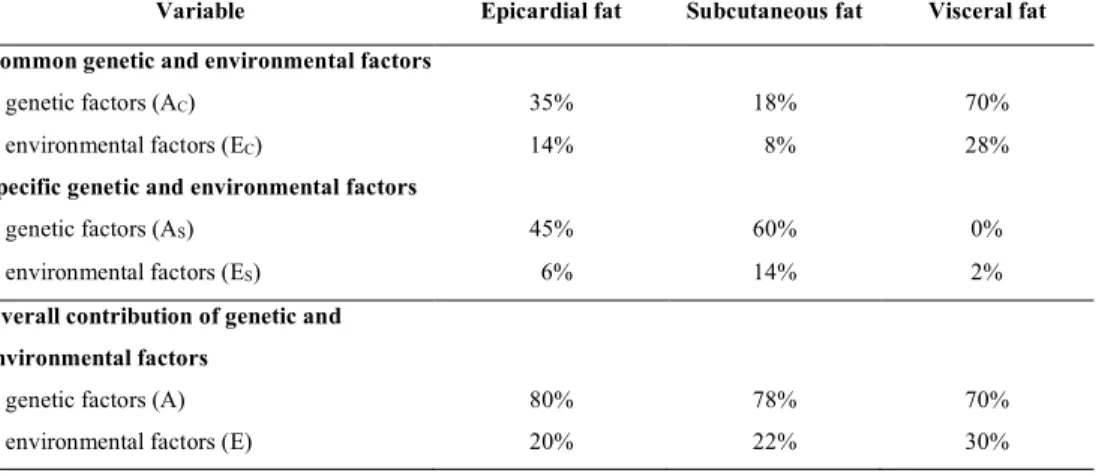
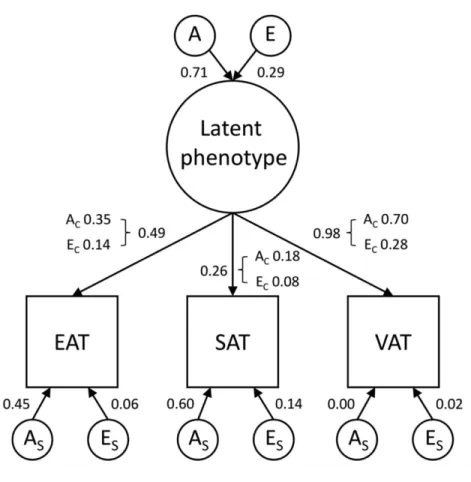
![Table 3. Clinical characteristics and main laboratory findings in CAD-negative and CAD-positive patients [n (%), mean±SD)]](https://thumb-eu.123doks.com/thumbv2/9dokorg/1361318.110867/13.630.69.541.215.747/table-clinical-characteristics-laboratory-findings-negative-positive-patients.webp)
